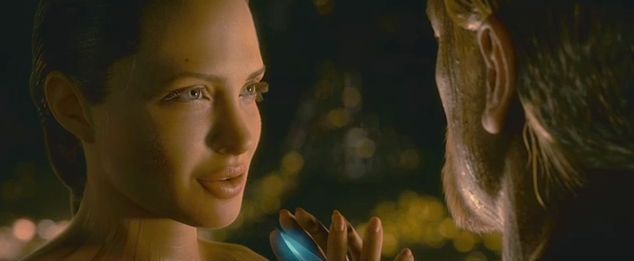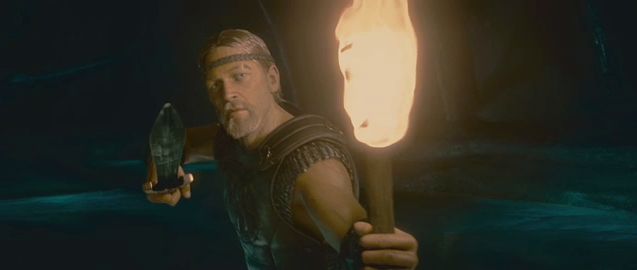Robert Zemeckis’ new computer-animated epic Beowulf is modelled as the future of cinema. Designed for high-definition digital 3-D projection, it is Hollywood’s latest attempt to create a unique theatrical experience that can’t be downloaded. Yet the film is something of an oddity. Despite Zemeckis having paid tribute to the classic cartoonists with his 1988 feature Who Framed Roger Rabbit?, his new film is deeply at odds with the traditional practice of animation.
Beowulf advances “performance-capture” techniques Zemeckis had previously used on his 2004 film The Polar Express, in which the movements of actors are mapped directly onto digital characters. Peter Jackson did a similar thing to use performances by Andy Serkis as the basis for Gollum in his Lord of the Rings trilogy and Kong in King Kong, with celebrated results. Yet Jackson was working to achieve characters that couldn’t be achieved by traditional means, and the motion-captured performance was considerably reworked by a team of animators.
Zemeckis’ use of the technology is more literal. While Beowulf includes some non-human characters (including a spectacular dragon and the Gollum-esque demon Grendel), most are human and many are direct likenesses for the actor playing the part. So, for example, Anthony Hopkins has his movements transferred onto a computer generated character that looks like… Anthony Hopkins.
What used to be thought of as the principal art of animation – creating performances through frame-by-frame alteration of the characters – is marginalised. For most of the characters in Beowulf, the animators’ involvement is a technical touch-up and no more.
The approach has a precedent in traditional hand-drawn animation. In that medium a device called a rotoscope is used to allow animators to trace live-action footage of real actors. When Walt Disney made Snow White and the Seven Dwarfs, the rotoscope was used to help his animators come to grips with the difficulties of animating realistic human characters.
Yet Disney quickly discovered that sticking closely to literal realism yielded disappointing results, with the resulting animation looking stiff and inexpressive. The animator’s art is in creating a performance through movement, and that calls for an element of exaggeration and graphical expressiveness that is stifled by the rotoscope. In Snow White the best animation turned out to be that which departed the most from the performance of the actors.
Some who use the new motion-capture technology have learnt those lessons. The performances of Kong and Gollum in Peter Jackson’s films are remarkably effective – and still the high water marks for realistic computer character animation – because they used Andy Serkis’ performance only as a starting point. Those justly hailed animated “performances” were collaborations between the actor and animators.
In the Zemeckis films, however, animated characters are a high-tech variation on costumes and make-up, digitally poured straight over the actors. There is none of the comic or dramatic exaggeration that a traditional animator would add. This is why the humans in Beowulf often seem so lifeless and off-putting, compared to the less realistic but truly animated characters in films that spurn motion capture such as The Incredibles or Ratatouille.
Despite this, the use of motion-capture is growing. It is easier to produce than traditional frame-by-frame animation, and live-action directors feel it provides a means for them to make the leap to animation, as they can direct the actors in a manner they are used to. Even more superficially “cartoony” features have adopted the technique, with last year’s Happy Feet and Monster House both being largely animated through motion capture.
Audiences don’t seem to appreciate the difference. Happy Feet was a huge hit, and won the Oscar for Best Animated Feature, despite the generally appalling quality of its character animation. Traditional animators feel understandably threatened by the creeping sense that their art doesn’t matter, and that anybody can make an animated film.
Happy Feet director George Miller, in particular, raised the ire of animators with his comment to the Washington Post that he “knew even the greatest animators in the world would take a lifetime to pull off the nuances of dancing that a gifted dancer is able to pull off.” Animation historian Amid Amidi responded caustically at his website Cartoon Brew: “if Miller feels this way about the potential of the lowly animation art and its artists, why the hell is he directing animated films?”
The makers of Ratatouille expressed a similar sentiment, taking a swipe at motion-captured rivals such as Happy Feet with a credit at the end reading: “Our Quality Assurance Guarantee: 100% Genuine Animation! No motion capture or any other performance shortcuts were used in the production of this film.”
Zemeckis at least acknowledges the debate, telling the International Broadcasting Convention this year that to call the process used for Beowulf “animation” was a disservice to the great animators of the past. Yet calling performance-capture something other than animation doesn’t answer the question: what artistic purpose does the hyper-realist look of Beowulf serve, exactly?
Ironically, the question is raised most sharply by the film’s most successful moments. Every so often, there is a shot of the characters rises above the zombie-like deadness of most of the animation to appear startlingly lifelike. At those moments you feel like you could be looking at a live-action shot of a real actor.
But what is the point of an artform that aspires, through the application of highly advanced computer technology, to successfully duplicate the impact of the century-old technology of live-action film? If completely realistic humans are the aim, then Zemeckis might as well have shot his actors conventionally.
The answer is that in Beowulf, animation has become a means to an end. Zemeckis loves his flashy shots, with camera and characters spinning through space, or the audiences’ viewpoint shooting in and out of extreme close-ups. The virtual environments in Beowulf give him far greater flexibility to film that way. The effect is further enhanced by presentation in 3-D, and computer-generated locations are well-suited to the 3-D process.
Zemeckis could have used human characters and inserted them into digital environments, as occurred in films such as 300, Sin City, and many scenes in the Star Wars prequels. However, if the camera is to be highly mobile, it becomes increasingly complicated (and limiting) to work with live actors. Perhaps more importantly, though, real actors highlight the fakeness of the virtual sets. Watching the Star Wars prequels, it is constantly jarring to see the live-actors in computer-generated environments. The locations are spectacular, but they never seem real.
In Beowulf, the settings have that same fakeness, but we don’t fault their lack of realism, because it is an animated film and we don’t expect absolute realism in the environments. The characters don’t look out of place the way live actors do, either – in this respect their synthetic appearance works in their favour, as it just makes them of a piece with their surroundings.
What Zemeckis-style motion capture does, then, is separate the medium of animation from the artform of animation. We get the “not-real” imagery that has always defined the medium, but without the frame-by-frame creation of performances which used to define the artform. Zemeckis isn’t interested in reproducing that (at least not in Beowulf).
Animation, for him, seems to be principally about freeing himself from the shackles of live-action. Since so many of the special effects in a modern blockbuster are produced through computer animation, Zemeckis appears to have shifted into animation simply to remove the fiddly business of blending the two forms seamlessly together.
This creates enormous freedoms for him, and Beowulf might yet herald bold developments in film making. It will not, however, ever be thought of as a landmark film in the history of animated performance.
Related Items
My review of Beowulf is here.

